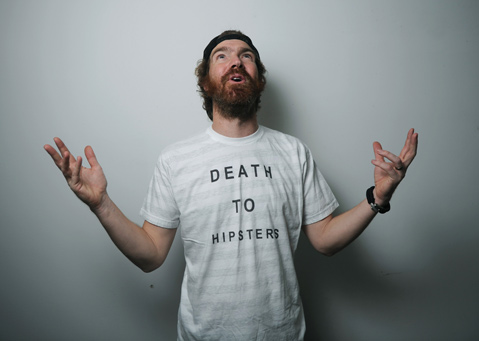The Struggle is Real

It is a Monday morning, sometime in that dark-gray yet ever-brightening hour just before daybreak. I am sitting at my dining room table on the eastside of Santa Barbara, staring down the glow of my computer screen, mildly organized stacks of papers and envelopes and assorted other debris of my modern life scattered around me. The table, it would seem, pulls double duty as a home office for both me and my wife. There are notebooks filled with interviews and observations from assorted stories still on deadline for multiple publications, architectural drawings from no less than three separate projects, the must-pay-now stack of bills with a bright-colored “Collection Agency” letter on top, the not-yet-opened envelopes of less-pressing bills and pointless correspondence from credit card companies and junk mailers, two recent paychecks, a tape recorder, pens, three dirty mugs, and a brilliantly blooming vase of night lilies that I brought home from the Farmers Market just a few days ago. Outside, a murder of crows wails from the power lines overhead as a MarBorg truck finds its way noisily into second gear on the uphill of Milpas Street. Yet another postcard-perfect day is exploding in the eastern sky, the warmth of it just starting to be reflected above the outline of the Mesa. I take it all in through the window next to me, my hunched-over reflection transposed over the entire scene. “Surviving Santa Barbara,” I say out loud to no one. “Surviving Santa Barbara.”
I first turned up in the 9310-something zip code late in the summer of 1998. A transplant from the East, I have always said that surfing brought me here, but, in the course of working on this issue of The Santa Barbara Independent, I have decided to change that answer. Life brought me here. I was 19, had recently dropped out of a prominent and disturbingly privileged New England liberal arts college, and was in dire—yet unknowing—need of something real. I had no idea what I was getting into, let alone that some 16 years later I would still be here, married to the love of my life (whom I met while waiting for the bathroom at Casa de la Guerra) and preparing to have my first child sometime this spring at Cottage Hospital. I had no idea that this little city by the sea would become my home, nor did I have any clue as to just how hard such a transition would be to pull off. Ignorance, as they say, is bliss.
I moved into a duplex on the Mesa that August. It was a real-life Real World MTV situation: seven guys in unit A and eight girls in unit B, all of us between the ages of 18 and 20. City College was our neighbor on one side, and its students were our neighbors everywhere else. I signed up for a couple of classes and somehow lucked into my first journalism job with the News-Press. Over the course of the next year, I would be evicted twice, fired from my job, witness my first and second drug overdose, and have way too much fun chasing waves and good times with new friends, exploring the wilderness that is our backyard, and being treated to ridiculously sublime sunsets nearly every day. It was a turbulent but perfect point of entry into life on the South Coast for a guy my age. Of course, the Massachusetts plates on my 1986 Chevy Corsica got me my fair share of grief in the surf world, complete with slashed tires and physical threats, but everything else, at least when looked at through the clarifying prism of hindsight, had me fast falling in love. It is said often — but only because it is Santa Barbara’s greatest truth — that this place is intoxicatingly beautiful, but a close second to the intersection of our geography and climate is the pace of life that it fosters, one that practically demands you prioritize the quality of your life or else. In transit at San Francisco Airport a handful of years ago, a guy at a barstool next to me noticed my Santa Barbara Bank & Trust credit card and offered in a direct, half-buzzed manner, “I used to live there. Unbelievable place. Nowhere like it that I have experienced before or since. From the mayor to the average guy living with three generations of his family under one roof, that whole town works to live rather than lives to work. It used to drive me crazy.” And while I know this city too well to make such a reductive comment myself, I also know exactly what this man was on about, Santa Barbarians know how to live. After all, why else would you hustle so hard to live in a certifiable paradise if you aren’t also going to take the time to enjoy it?

For me, my “survival story” has taken me through at least four different versions of myself on the way to my current situation as editor-at-large of The Indy. I have lived on couches in friends’ living rooms and in my truck along East Camino Cielo and the Gaviota Coast, illegally built studios, a flop house on Bath Street with 13 other roommates (each of us with our own signed rental agreement!), and no fewer than six different traditional houses and apartments. I have worked as an overnight security guard, a school teacher, a carpenter, a day-laboring landscaper, a grower for a medical cannabis club, a bell hop, a secretary, a sous-chef, a social media strategist, and a cold-calling stone salesman for a rock salvage company. I have waited in line at a shelter for a warm meal and humbly taken packaged food handouts from a church. I have swallowed my pride and called home and asked my parents for help and also stupidly spent my last dollar on a beer run at Ray’s Liquor. I have watched as my classmates from that aforementioned East Coast college have gone on to success and parenthood and home ownership and all those traditional trappings of adulthood years ahead of me mostly because of where I have chosen to grow my roots. The age 40 isn’t too far off, and I work three jobs, I live paycheck to paycheck, my wife is in essentially the same boat, and we are genuinely happy to be here, constantly marveling at the treasure of a town that has become our community despite the fact that we are in no immediate danger of having the means to open an actual savings account. If nothing else, for the vast majority of us, whether we are interloping transplants or long-established locals, surviving Santa Barbara means sacrifice and determination because without the two, unless you are among the 1 percent, it just isn’t going to happen — and even then, the occasional twist of good luck will be more than appreciated.
But really, there is more to it than that. After all, the struggle is real and relative no matter what town or city you choose to take your stand in. So what is it about surviving Santa Barbara? What makes this a story worth celebrating? Like so much in this life, it is the details that give it its greater meaning: the fact that we are a city of 90,000 people packed into 41 idyllic square miles of south-facing coastline in between the Pacific Ocean and the Santa Ynez Mountains; the fact that we are a community of incredible wealth and unmissable poverty with an increasingly hard-to-find and hard-to-sustain middle class; and that we are a shiny, happy, top-tier tourism stop for travelers the world over, yet so many of our longtime and multigenerational residents will be quick to point out that Santa Barbara is a far cry from the Eden it used to be. We are the birthplace of the environmental movement, willing host of the oil industry, escape plan for the rich and beautiful, home of the confetti egg, and not-so-proud owners of a mild gang problem. We are the northernmost edge of Southern California yet adamant to keep L.A. 100 miles away. As a city, we are slow-growth or no-growth oriented, yet our daily living experience makes us a place that most would want to try and live. There is a wonderful tension in all of these things that makes Santa Barbara, for good or bad, exactly what she is: a place where simply surviving, more often than not, is an unbridled display of a life that is thriving.


